- New Sailboats
- Sailboats 21-30ft
- Sailboats 31-35ft
- Sailboats 36-40ft
- Sailboats Over 40ft
- Sailboats Under 21feet
- used_sailboats
- Apps and Computer Programs
- Communications
- Fishfinders
- Handheld Electronics
- Plotters MFDS Rradar
- Wind, Speed & Depth Instruments
- Anchoring Mooring
- Running Rigging
- Sails Canvas
- Standing Rigging
- Diesel Engines
- Off Grid Energy
- Cleaning Waxing
- DIY Projects
- Repair, Tools & Materials
- Spare Parts
- Tools & Gadgets
- Cabin Comfort
- Ventilation
- Footwear Apparel
- Foul Weather Gear
- Mailport & PS Advisor
- Inside Practical Sailor Blog
- Activate My Web Access
- Reset Password
- Customer Service

- Free Newsletter


How to Perform Your Own Pre-Buy Inspection

Beneteau 323 Used Boat Review
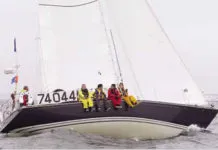
C&C 40 Used Boat Review

Sabre 386 Used Boat Review

How Does the Gulf Stream Influence our Weather?

Can You Run a Marine Air-Conditioner on Battery Power?

Preparing Yourself for Solo Sailing

Your New Feature-Packed VHF Radio

Practical Sailor Classic: The Load on Your Rode

Anchor Rodes for Smaller Sailboats

Ground Tackle Inspection Tips

Shoe Goo II Excels for Quick Sail Repairs

What Oil Analysis Reveals About Your Engine

An Unusual Sailboat Shines a Light On A Sustainable Future

Is It Time to Get an Electric Dinghy Motor?

Bottom Paint 30-Month Update

Battle of the Teak Cleaners — Snappy Teak-Nu vs. Star Brite

New Seacocks for the Offshore Sailor

Bottom Paint Care

Are E-bikes Worth the Extra Weight and Cost?

How to Handle the Head

How to Select Crew for a Passage or Delivery

Preparing A Boat to Sail Solo

Re-sealing the Seams on Waterproof Fabrics

Waxing and Polishing Your Boat

Reducing Engine Room Noise

Tricks and Tips to Forming Do-it-yourself Rigging Terminals

Marine Toilet Maintenance Tips

Learning to Live with Plastic Boat Bits
- Sailboat Reviews

S2 8.5 Meter
The 8.5 is good for cruising the coasts in comfort and style--as long as you like the modern look..
When Leon Slikkers founded S2 Yachts in 1973, much of the attention to detail that had previously characterized Slickcraft powerboats—Slikkers’ earlier boatbuilding venture— traveled with him to the new boatbuilding company. In the 13 years S2 sailboats were in production (S2 still makes powerboats), the company produced a variety of modern cruising designs from the board of Arthur Edmunds, all characterized by longish fin keels, freestanding spade rudders, straight sheerlines, and a staggering variety of draft options and cockpit locations.
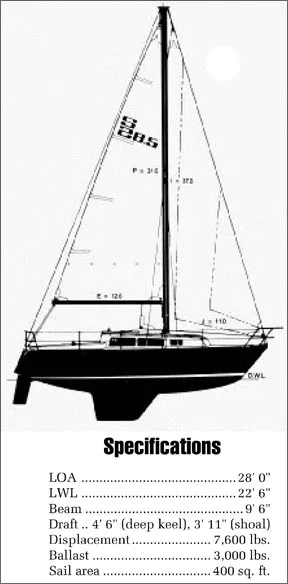
In the early ’80s, S2 reached more for the performance market with the Grand Slam series of small boats, and the 10.3 “offshore racer-cruiser.” These higher performance boats were designed by Scott Graham and Eric Schlageter, well known for their MORC and smaller IOR designs.
The S2 8.5 is a 28-footer cast in the company’s traditional mold. Her hull dimensions, sail area, displacement, and general design characteristics put her square in the middle of the modern 28-footers such as the Tanzer 8.5, Newport 28, O’Day 28, and the Pearson 28.
The boat’s styling is conventionally modern. She has a fairly straight sheer, fairly high freeboard, and low, raked cabin trunk with dark tinted flush ports. Production of the 8.5 ran from 1981 to 1983. The boat was replaced by the similar S2 8.6, which continued until S2 stopped making sailboats in 1986.
Construction
The hull of the S2 8.5 is a solid hand layup. Glasswork is excellent, and is noted by owners as one of the main considerations in buying the boat. Gelcoat quality is excellent.
Slight roving printthrough is evident, but it is not objectionable. Minor hard spots are visible in the topsides, probably caused by the attachment of interior furniture and bulkheads.
The deck molding is cored with end grain balsa, giving a solid feel underfoot as well as providing reasonable insulating properties.
S2’s hull-to-deck joint is the basic type that we would like to see adopted throughout the industry. The hull molding has an inward-turning flange, onto which the deck molding is dropped. The joint is bedded in flexible sealant, and through bolted on six inch intervals by bolts passing through the full length slotted aluminum toerail. The joint is also through bolted across the stem.
All deck hardware is properly through bolted, although pulpits, cleats, and winches merely use nuts and washers on the underside of the deck, rather than the aluminum or stainless steel backing plates we prefer.
Another feature of the hull-to-deck joint is a heavy, semi-rigid vinyl rubrail at the sheerline, quite aptly termed a “crash rubrail” by S2. This will go a long way toward absorbing the shock of the inevitable encounters with docks and the other hard objects that seem to be attracted to the topsides of the typical sailboat. Although this rail is black when the boat is new, it had dulled to a chalky gray on older S2’s we examined.
The builder advertises “bronze seacocks on all through hull fittings.” These are not traditional tapered plug seacocks, but are ball valves mounted directly to through hull fittings. A proper seacock—whether it uses a ball valve or a tapered plug—has a heavy flange to allow through bolting to the hull. This is an important safety feature. Should a valve seize, it may become necessary to apply a great deal of leverage to the handle in order to open or close the valve. The deeply threaded through hull stem can easily break under these conditions, and more than one boat has been lost in this manner.
We also suggest that seacocks be installed on the cockpit drain scuppers and the bilge pump outlet, both of which may be under water while the boat is sailing. Light air performance would benefit by the fairing in of the through hull fittings, particularly the head intake and discharge, both of which are far enough forward to have a significant effect on water flow past the hull.
Ballast is a 3,000 pound lead casting, epoxied inside a hollow keel shell. We prefer an external lead casting bolted to the hull for its shock-absorbing qualities and ease of repair. This preference was reinforced recently when we examined an old Bristol 27 just sold by a friend. The surveyor noticed dampness near the bottom of the leading edge of the keel, which showed slight external damage. Probing the loose putty revealed some abrasion of the glass keel molding. In order to sell the boat, it was necessary to grind away a large portion of the glass at the front of the keel, dry out the ballast, and reglass the lead—a job that took several days of work and cost our friend a fair chunk of money.
Much of the boat’s interior structure is plywood, glassed to the hull. Fillet bonding is neat and workmanlike with no rough edges to be found.
Chainplates are conventional stainless steel flat bar, bolted to bulkheads and plywood gussets in the main cabin. These are properly backed with stainless steel pads. Due to the fact that the hull is lined throughout with a carpet-like synthetic material, it is not possible to examine the bonding of the chainplate knees to the hull. The stemhead fitting is a stainless steel weldment, through bolted to the deck and hull and reinforced inside the hull with a stainless steel gusset to prevent deflection of the deck from the pull aft of the headstay. We’d like to see a metal backup pad behind this fitting rather than the washers which are used.
General construction is thoughtful and well executed, with excellent glasswork, a strong and simple hull-to-deck joint, and reasonably installed hardware and fittings.
Handling Under Power
Although some early models of the 8.5 used a seven horsepower BMW diesel, the 1982 version employs an eight horsepower Yanmar. These small Yanmars are quite impressive, light in weight and far smoother than the company’s older rockcrushers.
Because of the high freeboard and considerable windage of the 8.5, the standard engine is the absolute minimum power plant for the boat. Recognizing this fact, the company offered a 15 horsepower, two-cylinder Yanmar as an option. For another 75 pounds and $1,150, we would want this option on the boat if the ability to get places under power is a real consideration.
The extra fuel consumption of the larger engine will scarcely be noticed. The 18 gallon aluminum fuel tank will probably give a range under power of over 250 miles—more than adequate for a 28 foot cruising boat.
The fuel tank is located under the cockpit and is securely mounted and properly grounded. There is an easily reached fuel shut off between the engine and tank. Unfortunately, the fuel fill is located in the cockpit sole. Spilled diesel oil turns even the best fiberglass nonskid into an ice skating rink. Fuel fills should be located on deck, where spills can be efficiently washed away.
Engine access is via a large removable panel on the inboard face of the quarterberth. This panel lacks any kind of handhold to make it easily removable, which will discourage regular checking of the engine oil. The top companionway step also removes for access, but it’s a long reach to the dipstick.
There is no oil pan under the engine. It will be necessary to be very careful when changing oil to keep the bilge clean. We have yet to see anyone change oil and filters on a boat engine without spilling something.
With the quarterberth panel removed, access for routine service is excellent. The quarterberth has remarkable headroom over, so that the mechanic will not feel like a trapped spelunker after a half hour of work. Engine removal will require some joinerwork disassembly.
Handling Under Sail
The S2 8.5 is no slug under sail. Her PHRF rating of 174 to 180 compares very favorably to other boats of her size and type. The Sabre 28, for example, has a rating of 198. The Pearson 28 about 195, and the O’Day 28 about 198.
Part of this is no doubt due to the fact that the standard sails on the boat come from the North loft. While North’s OEM sails may not be the vertical cut Mylar-Kevlar wonders that adorn custom boats, they’re a lot better than most.
S2 now uses Hall spars. The simple masthead rig is extremely clean, with airfoil spreaders and internal tangs. The boom features an internal outhaul and provision for two internally-led reefing lines, with cam cleats at the forward end of the boom.
The deck-stepped mast is mounted in a stainless steel deck plate incorporating plenty of holes for the attachment of blocks. Halyards and Cunningham lead aft along the cabin house top to a pair of Lewmar #8 winches. Lewmar #16s are optional, but hardly necessary.
The main is controlled by a six-part Harken rig mounted on the end of the boom, and a Kenyon traveler mounted on the aft cockpit coaming. This will work fine with the tiller-steered version of the boat. With wheel steering, the mainsheet is likely to be a nuisance to the helmsman.
Because of the end-of-boom sheeting, a boom vang will be essential for full mainsail control. Ironically, the boat’s drawings show almost mid-boom sheeting, with the traveler mounted on the bridgedeck at the forward end of the cockpit. This is probably a better arrangement, although it heavily loads the center of the boom and requires more sheeting force.
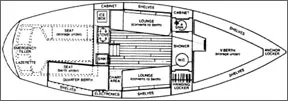
Despite the fact that the shrouds are set well in from the rail, the boat lacks inboard headsail tracks. Rather, you are limited to snatch blocks shackled to the toerail track. A six-foot piece of track set inboard of the rail would be a useful addition.
Standard headsail sheet winches are two-speed Lewmar #30s. Options include both larger winches and self-tailers, both of which are worth considering for either racing or cruising. The cockpit coamings are wide enough for mounting larger primaries and secondaries.
The high-quality rig and sails add to the price of the S2, but they are additions well worth the cost.
Deck Layout
The deck layout of the 8.5 is clean and functional, with no toe stubbers to catch you unawares. There are two foredeck mooring cleats, but no bow chocks. The necessity to lead an anchor line well off the boat’s centerline, coupled with high freeboard forward, is likely to result in a boat which sails around on her anchor or mooring. The 8.5 has a pair of wide stainless steel chafing strips at the bow which will greatly protect the deck from the chafe of the anchor line.
The 8.5’s foredeck anchor well is one of the best we’ve seen. It is shallow—just deep enough to hold an anchor and adequate rode. There are double scuppers, which offer less likelihood of clogging. The lid is held on by a full-length piano hinge, and there is a positive latch.
The shallow locker well above the waterline means that water is less likely to enter through the scuppers, which can be a real problem with a deep anchor well. When the bow pitches into waves, a deep anchor well can fill with water, and if the scuppers clog with debris, you can find yourself sailing around with several hundred pounds of extra weight in the worst possible position. There is no provision for securing the bitter end of the anchor rode, but a big galvanized eyebolt installed in the well by the owner will solve that one.
The running lights leave something to be desired. Their location at deck level just aft of the stem makes them vulnerable to damage when handling ground tackle. We much prefer an international style bicolor mounted on the pulpit, another two feet off the water: easier to see, and out of the way. Wiring for the running lights is exposed in the anchor well, and should be secured out of the way.
A recessed teak handrail runs the full length of the cabin trunk, serving the dual function of heavy weather handhold and cabin trim piece. Its shape makes it far easier to oil or varnish than the conventional round handrail, although the wide, flat section seems somewhat awkward after years of grabbing round rails.
The 8.5’s cockpit is the maximum size we’d want to see on a boat of this size. The T-shape is designed to accommodate the optional wheel steerer, yielding a somewhat odd layout for the tiller-steered version. A bench seat spans the aft end of the cockpit. Although this makes good seating in port, we doubt that you’d want anyone sitting there under sail: too much weight in the end of the boat. It does make a natural helmsman’s seat for wheel steering.
The engine controls and instrument panel are also located at the aft end of the cockpit, and are basically inaccessible to the helmsman of a tiller-steered version.
There are two lifting lids in the aft cockpit bench, giving access to a cavernous space under the cockpit. To be useful, dacron bags should be fitted to the inside of these lockers. Then, they’ll be handy stowage for spare sheets and blocks.
There are comfortable contoured seats along each side of the cockpit, with a huge locker under the port seat. Although plywood pen boards somewhat separate this locker from the engine space under the cockpit, it would be far too easy for deeply piled junk to get knocked over the board and into the engine. This locker should be partitioned into smaller spaces unless it is to be used exclusively as a sail locker.
The battery boxes, fitted at the forward end of the locker, could benefit from plywood or fiberglass lids to keep battery acid off gear which might find its way onto the batteries. The box is designed to take two batteries—one battery is standard—stored in plastic containers. A single lid covering the whole box would be more efficient.
The huge cockpit will accommodate up to six for sailing, and eight for in-port partying. The cockpit seat bottoms are contoured, and the cockpit coamings slope outboard for more comfortable seating. However, the seats are both too narrow and too short for sleeping.
The forward end of the cockpit is protected by a narrow bridgedeck. However, the cockpit coatings extend a full foot above the level of the bridgedeck, To block the companionway to the level of the top of the coamings will require leaving two of the three drop boards in place when sailing.
Although there is moderate taper to the sides of the companionway, making it easier to remove the drop boards, it is still necessary to lift each board about five inches before it can be removed. This is far safer than many tapered companionways, where boards practically fall out if you look at them wrong. The companionway slide is one of the best we’ve seen. It’s a contoured piece of acrylic fitted with a convenient grabrail. It slides easily in extruded aluminum channels, and is fitted with a fiberglass storm hood. As on many boats, the aft cabin bulkhead slopes forward, rendering it impossible to leave the drop boards out for ventilation when it rains.
Owners consistently praise the interior design and finishing of S2 sailboats. From looking at the 8.5, it’s pretty easy to see why.
There are no exposed interior fiberglass surfaces except the head floor pan molding. The hull and cabin overhead are lined with a carpet-like synthetic fabric. While this will undoubtedly cut down on condensation, we at first wondered how this fabric would hold up over time. Inevitably, the hull liner and even the overhead will get wet. In freshwater areas, this is no problem. The water will eventually evaporate. In salt water, however, wet fabric never seems to dry. Salt draws moisture like a magnet draws steel. Since first seeing this boat, however, we’ve had good experiences with the fabric. Be sure, however, to get a good wet-or-dry vacuum to keep it clean.
Interior layout is fairly conventional, with Vberths forward, and immediately aft, a full width head. The head can be closed off from both the forward cabin and the main cabin with solid doors—a real luxury in a boat this size. There is a large hanging locker in the head, and reasonable storage space for toilet articles.
The word for the main cabin is “wide,” with the settees pushed as far outboard as they can go. Décor is a little heavy on the teak for our taste, but it is one of the better coordinated interiors we have seen. S2 had a good interior decorator.
A fold-down dining table seats four. When folded against the bulkhead, it is held in place by a single latch, which makes us nervous.
Neither settee is full length. The foot of the port settee runs under the galley counter, making it long enough for sleeping, although your feet may feel a little claustrophobic in the tiny footwell.
The starboard settee is an unusual configuration. The aftermost 12″ of the settee folds up to form an arm rest, leaving a gap between the end of the settee and the head of the quarterberth.
Inexplicably, this gap is referred to on the accommodation plan as a “charting area,” although there is neither a standard nor an optional chart table. It’s sort of like the designer ran out of energy before completing the interior design.
Over the non-existent “charting area” is the best electrical panel we’ve seen on a 28 foot boat. The panel has a locking battery switch, battery test meter, and a panel with room for 14 circuit breakers, although only half are installed on the standard boat.
The space is welcome, since with the proliferation of marine electronics most electrical panels are woefully inadequate.
Most quarterberths tend to induce claustrophobia. That of the 8.5 is more likely to exacerbate any tendencies you might have to agoraphobia. At last, a quarterberth which will not give you a concussion when you sit bolt upright in the middle of the night after your neighbor drags down on you in a wind shift.
The standard main cabin sole is carpet-covered fiberglass. For an additional $325, teak and holly was available for the traditionalist. We’d want it. Unfortunately there is no access to the bilge in the main cabin. None. This is inexcusable, and could be dangerous. A few hours with a saber saw should solve this rather basic problem.
The galley is workable and accessible, with no awkward posturing required to do the dishes. The sink gets an A+. It is a full nine inches deep, is large enough to take a frying pan, and mounted close to the centerline.
In contrast, the icebox gets a C-. It is larger than normal on a boat of this size, but it drains to the bilge, has a poorly insulated top, and a tiny, uninsulated hatch without a trace of a gasket. Boo.
Because of limited counter space, the two burner Kenyon alcohol stove is mounted athwartships, rather than fore and aft. This means that the stove cannot be gimballed, and that it is necessary to reach across the inboard burner to reach the outboard one. Given the fact that countertop gimballed stoves are usually dangerous, the lack of gimballing doesn’t bother us much. What does bother us is that if you want to upgrade the stove to something more functional, the limited space allocated will stretch your ingenuity.
A fold down table at the end of the galley counter gives additional counter space, but it must be left up in order to use the port settee for sleeping.
Roominess, excellent execution, and good color coordination are trademarks of the interiors of all S2s, and the 8.5 fits well into this enviable tradition.
Conclusions
The S2 8.5 is a good boat for cruising the Great Lakes or any coast in comfort and a certain amount of style. Her appearance may be a little modern for traditionalists, with her straight sheer and European-style cabin windows.
Pricey? Yes, but when you look at the things that go into the boat—the rig, good sails, and a comfortable, well finished interior—the price may seem a bit less painful. You still pay for what you get.
RELATED ARTICLES MORE FROM AUTHOR
Leave a reply cancel reply.
Log in to leave a comment
Latest Videos

The No Expense Spared Antigua 60 Cruising Sailboat Soolaimon

How To Buy Sails – With Joe Cooper

Bavaria C42: What You Should Know | Boat Tour

Universal Diesel Engines – What You Should Know
- Privacy Policy
- Do Not Sell My Personal Information
- Online Account Activation
- Privacy Manager
- BOAT OF THE YEAR
- Newsletters
- Sailboat Reviews
- Boating Safety
- Sailing Totem
- Charter Resources
- Destinations
- Galley Recipes
- Living Aboard
- Sails and Rigging
- Maintenance

Slick, Sleek, and Slikkers-Built
- By Gregg Nestor
- Updated: January 5, 2011
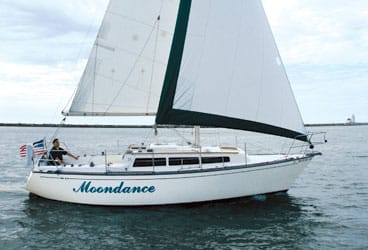
Leon R. Slikkers, a Michigan native who spent much more of his life building powerboats than sailboats, founded S2 Yachts in 1974. The sailboats are recognized for their performance, distinctive styling, and quality craftsmanship, and during its short history, S2 Yachts produced several sailboats that are still admired.
The 8.6 was introduced in 1983 and built until 1987. Naval architect Arthur Edmonds, whose best-known production sailboat is the Allied Princess 36, is credited with the design of the 8.6. He drew it with a somewhat flat sheer, moderate forward and aft overhangs, and a reverse transom. Together, these elements produce a balanced and graceful contemporary appearance.
The hull and deck are hand-laid fiberglass. While the hull is solid, all horizontal deck areas are cored with end-grain balsa. The deck joins the hull on an inward-facing flange to which it’s bonded and through-bolted. Below the water, the 8.6 has a spade rudder and was offered with a deep fin or a shoal-draft keel. Cast-lead ballast is encapsulated within a keel cavity that’s integral with the hull molding.
The accommodations of the 8.6 are fairly conventional. Forward is a V-berth with, just aft of it, a hanging locker and bureau. In the head compartment, a single fiberglass unit forms the sink, vanity, medicine cabinet, toilet base, and sole.
The main saloon features opposing settees and a bulkhead-mounted drop-leaf table. The L-shaped galley has a sink, an icebox, a two-burner alcohol stove, a convenient trash compartment, and a flip-up counter extension. Across from the galley is a generous single quarter berth with sitting headroom.
The S2 8.6 has a high-aspect-ratio masthead sloop rig with a small mainsail and an overlapping headsail. Jibs sheet to short tracks on the side decks, headsails through snatchblocks clipped to the toerail. The mainsheet is attached to the end of the boom and leads to a traveler that spans the transom. All sail controls, including the halyards, reefing lines, outhaul, and cunningham, are led aft through clutches—novel treatment in 1983.
The S2 8.6 is a very comfortable and easily managed coastal cruiser and club racer. It’s relatively stiff, its helm feels balanced, and it tracks well. On most points of sail, it compares favorably with other boats of similar size and type.
The standard 20-horse Yanmar diesel moves the boat well, and access to it for routine maintenance is excellent. The 18-gallon aluminum fuel tank is located just aft of the stuffing box.
A prospective buyer should pay particular attention to a few items. Any balsa-cored deck is a candidate for delamination. On the 8.6, one area of chronic leakage is around the chainplates. In the event of a grounding hard enough to damage the keel’s leading edge, water could enter the space between the fiberglass outer skin and the encapsulated lead ballast.
Despite having been designed more than two decades ago, the S2 8.6’s styling appears quite contemporary. The boats were well built and finished with care, and they tend to hold their value, so expect to pay from $14,000 to $23,000.
Gregg Nestor, a lifelong water rat, is the author of three books about sailboats.
S2 8.6 LOA 28′ 0″ (8.53 m.) LWL 22′ 6″ (6.86 m.) Beam 9′ 6″ (2.90 m.) Draft (deep/shoal) 4′ 6″/3′ 11″ (1.37/1.19 m.) Sail Area (100%) 390 sq. ft. (36.23 sq. m.) Ballast 3,000 lb. (1,361 kg.) Displacement 7,600 lb. (3,447 kg.) Ballast/D .39 D/L 298 SA/D 16.1 Water 37 gal. (140 l.) Fuel 18 gal. (68 l.) Engine 20-hp. Yanmar Designer Arthur Edmonds
- More: day sailing , fiberglass , keelboat , monohull , Sailboats , sailboats classic plastic
- More Sailboats
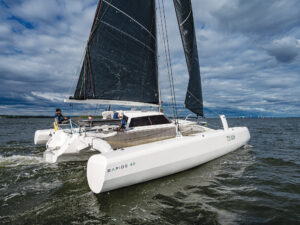
Sailboat Review: Rapido 40
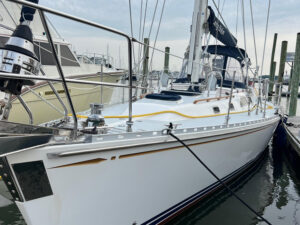
For Sale: 2002 Hylas 46
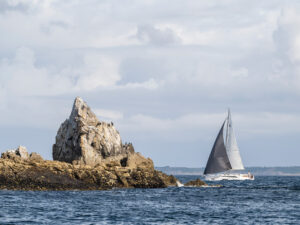
Sailboat Review: Beneteau Oceanis 37.1
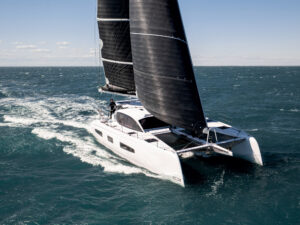
Sailboat Preview: Outremer 52

10 Gems of the BVI
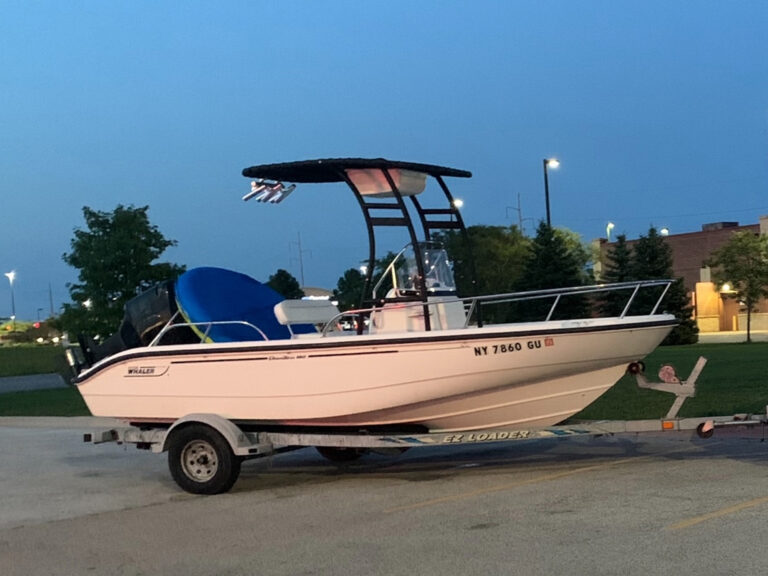
For Sale: A Freshwater Find
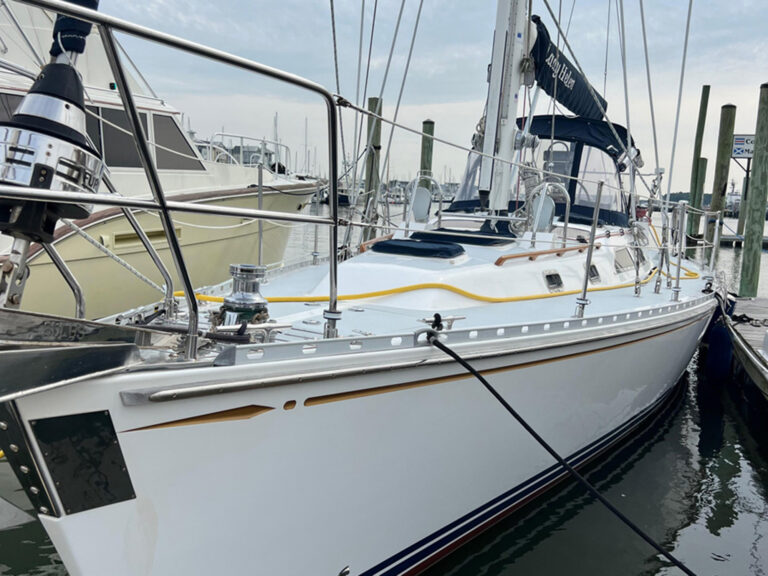
7 Boating Safety Tips for Summer Cruising
- Digital Edition
- Customer Service
- Privacy Policy
- Email Newsletters
- Cruising World
- Sailing World
- Salt Water Sportsman
- Sport Fishing
- Wakeboarding
Boats for Sale & Yachts
S2 8.5 sailboat 1982 boats for sale & yachts, s2 8.5 sailboat boats review and specs.
Table of Contents
1982 S2 Sailboat 28′ Sloop with wheel steering, main, roller furling genoa and self tailing winches and shore power High side rails, aluminum toe rail and stern ladder and BBQ grill Bottom paint and bimini top Cabin has forward v berth, privacy window curtains, quarterberth to starboard berth Sleeps Four comfortably with galley and head
Contact Information
S2 8.5 Boats for Sale Craigslist & S2 8.5 Specs & Pictures
Related posts:.
- Mirage 5.5 Sailboat for Sale *2020** New Mirage 5.5
- CS 34 Sailboat for Sale Yr. 1991
- Irwin 33 SAILBOAT 1977
- Columbia Boats Project Sailboat 1976
This entry was posted filed under All Boats . You can follow any responses to this entry through the RSS 2.0 feed. You can skip to the end and leave a response. Pinging is currently not allowed.

- Forum Listing
- Marketplace
- Advanced Search
- About The Boat
- Boat Builders Row
- SailNet is a forum community dedicated to Sailing enthusiasts. Come join the discussion about sailing, modifications, classifieds, troubleshooting, repairs, reviews, maintenance, and more!
Rigging Tensions on an 8.5?
- Add to quote
Just bought an 8.5 and have it mostly sorted out. Did notice the rigging was very loose. So loose that my furler would not drop or go up. Using the loos recommendation for 1/4" rigging I adjusted everything to around the 40 mark which translates to around 960Lbs if I remember correctly. The back stay would only adjust to around 830 or so. Even though it is not near what Loos recommended (around 1360) everything seems TOO tight. Everything is centered nicely and the mast is even with a slight rake to the rear. I have read too tight is better than too loose but I don't want to put any more stress on this old boat than is necessary. Were there ever any manufacturer's specs on the rigging tensions for this boat? Any recommendations, experiences, and reasonings would be extremely helpful.
What are you using to measure the tention on te rigging?
the loos gauge is used to set a starting point for the shrouds. the back stay tension is set to control the forestay sag ( luff curve ) when sailing. fore stay length sets the mast rake to control the balance of the helm.
I would recommend having a rigger out for the first time and have them show you. If you have it close and pins are out, it won't be a large expense. I am not sure where you read that too tight is preferable as it puts undue strain on the boat.
A rigger can only do what you have already done unless he is going to go sailing with you. if you are reading 40 on the loos B gauge you are about 1060 lbs which is 11% load on 1/4" wire you could go up to 15% so you are OK to go sailing and look at the rig while sailing. look up the mast and see if it is straight in column on both port and starboard tack and if not make adjustments to make it straight. fore and aft the tension is not as critical. you adjust the forestay length to set the mast rake angle which you have done. so the backstay tension is set to adjust the sag in the forestay when sailing up wind. many boats have adjustable backstays and will adjust while sailing any where form 0 to 20% to control the luff curve of the sail depending on wind speed. the 8.5 is masthead rig so the lower fore and aft shrouds can be used to put some bend in the mast to adjust to the luff curve of the mainsail. more bend the flatter the sail for the higher wind speeds.
I used a Loos B to arrive at the tensions. I have a PT2 on the way. The actual measurements are between 39-40. To answer the question about too tight vs too loose, the reasoning was that if a rig was too loose there would be a lot of banging around, pulling and tugging etc. Most articles I read said that too loose did more damage to the rig as a whole than did being too tight. When the new gauge gets here I do think I will back it down to the 850 range and take it out to see what it does. The thing that does concern me about things being tight dockside is that under way things will get much tighter (at least one side at a time will). I have a Furlex furler and the backstay is adjusted as much as it will go. I was only able to get in the 850 range there. Also, thanks for the input everyone. Quick response! Were there any spec tensions on this boat?
What you think is "too tight" is probably just right - in my experience most rigs except those on pretty serious racers are too loose. The leeward rigging should not be perceptibly slack when sailing in a breeze yet on most boats it flops around. P.S. tension specs are for the wire size, not the boat. Theoretically the wire should be tightened to 15% of its breaking strength.
This is probably a stupid question but is 15% tension the maximum tension while under sail or is that the standing tension dockside? Let's say that I am at 12% tension. What kind of load tension can I expect while under sail? Lot of variables involved I know but a ballpark at this point would be helpful. Should I take the boat out and back the tension off till the leeward rigging starts to flap and then add some back on to the point that it stops?
15% is the "conventional" number to set the unloaded rig at - the preset if you will. Loosening the leeward rigging until it flops and then taking the flop out plus a little more is the old standard "hand tuning". It has worked forever but is far less accurate or consistent from wire to wire than using a gauge. It's not dissimilar to tightening the head bolts on an engine without using a torque wrench - and with potentially much more catastrophic results than a leaking head gasket. Every owner should get a Loos and use it - they are fast & simple and you can find them cheap on Craigslist or similar from time to time. I got an almost unused one for $40 years ago and have had pretty accurately tuned rigs ever since.
There are cases of loosened rigging in S2 8.5s due to deck and or step compression. The deck has a balsa core susceptible to rot if leaks are not caught quickly. Below the deck to the keel is a wooden compression post atop a wooden mast step. The step is a transverse structural member beneath the cabin sole. In my 1980 8.5 the mast step began to rot. The space beneath the sole is very hard to inspect. My only access is through a small panel well aft. The first indication of the problem was displacement of the trim above the entrance to the head. The trim piece is now tilted about 1" down on the inboard side at the compression post.
- ?
- 174.5K members
Top Contributors this Month

- Forums New posts Unanswered threads Register Top Posts Email
- What's new New posts New Posts (legacy) Latest activity New media
- Media New media New comments
- Boat Info Downloads Weekly Quiz Topic FAQ 10000boatnames.com
- Classifieds Sell Your Boat Used Gear for Sale
- Parts General Marine Parts Hunter Beneteau Catalina MacGregor Oday
- Help Terms of Use Monday Mail Subscribe Monday Mail Unsubscribe
New S2 8.5 owner Plymouth ma
- Thread starter bikelessman
- Start date Jan 14, 2015
- Brand-Specific Forums
bikelessman
I'm a new 8.5 owner as of 3 weeks ago. Any 8.5 owners in the southeastern ma area? I've been going to town on the boat. Ripped out and replaced all the water piping. Put in new pressure water and also foot pump system. Sanded and refinished all teak inside and out. New Sealand self contained head with pump out and maceration pump with 3 way valve. New season for the galley sink. Ran and winterized the engine. Looks like the engine oil seal is leaking at the cranking handle. Not sure how serious that is? The rudder seems a bit sloppy has anyone ever pulled theirs out? Are there bearings at top and bottom? The mast rigging is loose but no soft spots on deck or crushing or cracking of the cross members or footing inside the cabin. I think I just need to tighten up the turn buckles. I do need to replace the two plastic port windows in the head, they are leaking. Anyone know what windows fit? I'd like to go with more robust ports. The winter is cold and dark but I plan on working every spare minute to get everything fixed by spring.
welcome to the forum
Thanks! It's nice to see there is a forum for S2's. I have lots of work to do before spring. I've already found many answers to my questions.
Welcme to the forum fellow 8.5 owner. I am in Milwaukee WI. It is cold and dark here too!! Good to hear that your deck is sold, mine is quite rotted. (currently doing a re coring project) I am not seeing crushing or cracking in the cabin, but there is a 'dimple' in the floor under the "compression post" and the geometry is off in the bulk head unger the mast. Does you boat have any of these issues?
jguyer said: Welcme to the forum fellow 8.5 owner. I am in Milwaukee WI. It is cold and dark here too!! Good to hear that your deck is sold, mine is quite rotted. (currently doing a re coring project) I am not seeing crushing or cracking in the cabin, but there is a 'dimple' in the floor under the "compression post" and the geometry is off in the bulk head unger the mast. Does you boat have any of these issues? Click to expand
Has anyone ever pulled the rudder out? I can't find any pictures or diagrams showing the bearing arrangement. My rudder seems loose in the tube. The rest of the rudder is solid. Are there bearings or is it just a tube with a sleeve?
if its like the 9.2 and probably is..... it is just a plastic bushing/sleeve mounted in a stationary block in the aft lazarette going through a bronze stuffing box and bronze tube.... not a very good pic but its all i got ...above all that in the pic is a block on the top side of the lazarette deck with a plastic/nylon bushing also
Attachments

woodster said: if its like the 9.2 and probably is..... it is just a plastic bushing/sleeve mounted in a stationary block in the aft lazarette going through a bronze stuffing box and bronze tube.... not a very good pic but its all i got ...above all that in the pic is a block on the top side of the lazarette deck with a plastic/nylon bushing also Click to expand
Bron said: Rudder bushing on the 8.5 is a thin nylon sleeve called a NYLINER. They are readily avaiable thorough industrial supply houses and are prety cheap - about $8 each several years ago. They are easy to replace but you must drop the rudder. Can be done in the water if you fashion a sling under the rudder before you pull the rudder head off the rudder stock. Once the rudder head is off, the rudder will drop right out. Even on shore, you have to have enough room under the boat for the rudder and stock to drop out of the rudder tube. Bron Lithirish S2 8.5 #088 Rocky River, OH Click to expand
Bron I think I found the bearings on Thompson Industrial Products Website. I think they are the 24L24FK model. Do I need 2 of them? One has a locking tab the other (24L24F) does not. The cost is $7.45 each in case anyone else is looking for them.
Looks like you found it. I think its the largest one they make if my memory serves me. I don't think I have a locking tab. I don't know what it would do. The NYLINER is free to rotate as a bushing inside the shaft between the shaft and the tube.You will need two - one top and one bottom. Removing rudder is a two man job, unless you have a system in place to hold it in place from the bottom (I made a rope sling to hold it up while I climbed down to guide the drop.) The rudder head has a pin in it that goes through the head and the rudder stock shaft. Once the sling is in place, tap the pin out with a long punch. It's grooved with tapered ends, so it moves easily. I have a hose clamp around it when in place so it doesn't slip out unintentionally.The rudder will free fall once the pin is taken out of the head. Rudder is probably 7+ feet long so you will need that much clearance to get it out of the shaft. I found my spares NYLINERS in the garage and I think you can slip them onto the shaft without dropping the rudder completely. It's a long flanged nylon tube which is split at an angle its entire length. Spread the tube at the split and it should slip around the shaft. Otherwise you have to drop it completely and slide it down the length of the shaft. I don't know if the cold will make it susceptible to cracking if split too much in winter. My setup is totally different from Woody's. Probably because I have a tiller instead of a wheel. The tube is a continuous tube from the bottom of the hull up to the underside of the cockpit seat. There are no terminations, or holes in that tube. Just glassed in at the bottom and at the top. I suspect a wheel would need a termination and shaft seal to accommodate wheel steering. pm me if you need more information. [email protected]
Just a quick follow up for others reading these posts. The rudder came off easily with one person. I simply placed a wooden block under the base of the rudder. Got up in the cockpit and with a hammer and a screw driver punched out the dowl pin in the rudder stock. The rudder slid down slowly onto the block of wood. I found that my bearings were completely missing that's why the post was sloppy. The new nyliner bearings have a tapered slit in them which allows you to slip them over the rudder shaft. I then lifted the rudder back up into position while sliding a larger wooden block under it bottom. Jumped back in the cockpit installed the top bearing over the shaft and put the top cap and dowl pin back in with a hammer. Easy job for one person and two block of wood.
- This site uses cookies to help personalise content, tailor your experience and to keep you logged in if you register. By continuing to use this site, you are consenting to our use of cookies. Accept Learn more…
Great choice! Your favorites are temporarily saved for this session. Sign in to save them permanently, access them on any device, and receive relevant alerts.
- Sailboat Guide
1980 S2 Yachts 8.5
- Description
Seller's Description
All Critics agree ,the S2 8.5 , 28ft Sailboat is a Great Boat . Very Comfortable Cruising or Racing. Very Good Condition with all the necessary equipment for a Turn Key Purchase . Newly Buffed to a Mirror Like Finish. Interior Teak , Washed , Brightened and Oiled A Two Owner Boat that has been beautifully maintained
Equipment: Electronics - Marine Band 2 Way Radio , Standard Horizon , used 2 seasons
Depth Gauge - Datamarine Model S100Kl Knot Meter - Datamarine Model S200DL Wind Direction and Speed - Data Marin />Batteries - West Marine 800MCA purchased 2021 Custom Winter Cover by Fairclough Rigging - Replaced 2013 and 2019 Main Sail - Good Cond. Working Jib - 100% Like New Spinnaker Sail - Very Good Genoa Sail - OK Winches - 2 Harken Self Tailing 2 Speed 1 Harken Self Tailing 1 Speed 1 Lewmar 1 Speed Main Sheet Traveler , Kenyon Compass - Suunto Head- Thetford Electric Engine , Sail Drive Great Condition and a Working Spare
Rig and Sails
Auxilary power, accomodations, calculations.
The theoretical maximum speed that a displacement hull can move efficiently through the water is determined by it's waterline length and displacement. It may be unable to reach this speed if the boat is underpowered or heavily loaded, though it may exceed this speed given enough power. Read more.
Classic hull speed formula:
Hull Speed = 1.34 x √LWL
Max Speed/Length ratio = 8.26 ÷ Displacement/Length ratio .311 Hull Speed = Max Speed/Length ratio x √LWL
Sail Area / Displacement Ratio
A measure of the power of the sails relative to the weight of the boat. The higher the number, the higher the performance, but the harder the boat will be to handle. This ratio is a "non-dimensional" value that facilitates comparisons between boats of different types and sizes. Read more.
SA/D = SA ÷ (D ÷ 64) 2/3
- SA : Sail area in square feet, derived by adding the mainsail area to 100% of the foretriangle area (the lateral area above the deck between the mast and the forestay).
- D : Displacement in pounds.
Ballast / Displacement Ratio
A measure of the stability of a boat's hull that suggests how well a monohull will stand up to its sails. The ballast displacement ratio indicates how much of the weight of a boat is placed for maximum stability against capsizing and is an indicator of stiffness and resistance to capsize.
Ballast / Displacement * 100
Displacement / Length Ratio
A measure of the weight of the boat relative to it's length at the waterline. The higher a boat’s D/L ratio, the more easily it will carry a load and the more comfortable its motion will be. The lower a boat's ratio is, the less power it takes to drive the boat to its nominal hull speed or beyond. Read more.
D/L = (D ÷ 2240) ÷ (0.01 x LWL)³
- D: Displacement of the boat in pounds.
- LWL: Waterline length in feet
Comfort Ratio
This ratio assess how quickly and abruptly a boat’s hull reacts to waves in a significant seaway, these being the elements of a boat’s motion most likely to cause seasickness. Read more.
Comfort ratio = D ÷ (.65 x (.7 LWL + .3 LOA) x Beam 1.33 )
- D: Displacement of the boat in pounds
- LOA: Length overall in feet
- Beam: Width of boat at the widest point in feet
Capsize Screening Formula
This formula attempts to indicate whether a given boat might be too wide and light to readily right itself after being overturned in extreme conditions. Read more.
CSV = Beam ÷ ³√(D / 64)
A few early boats were fitted with a BMW diesel. Shoal draft: 3.83’.
This listing is presented by SailboatListings.com . Visit their website for more information or to contact the seller.
View on SailboatListings.com
Embed this page on your own website by copying and pasting this code.
- About Sailboat Guide
©2024 Sea Time Tech, LLC
This site is protected by reCAPTCHA and the Google Privacy Policy and Terms of Service apply.

IMAGES
VIDEO
COMMENTS
The S2 8.5 is a 28-footer cast in the company's traditional mold. Her hull dimensions, sail area, displacement, and general design characteristics put her square in the middle of the modern 28-footers such as the Tanzer 8.5, Newport 28, O'Day 28, and the Pearson 28. The boat's styling is conventionally modern.
It takes into consideration "reported" sail area, displacement and length at waterline. The higher the number the faster speed prediction for the boat. A cat with a number 0.6 is likely to sail 6kts in 10kts wind, a cat with a number of 0.7 is likely to sail at 7kts in 10kts wind. KSP = (Lwl*SA÷D)^0.5*0.5
Very strong boat. Only downside is the total lack of drawer space needed for extended cruising. S. SailNet Archive Discussion starter. 87689 posts · Joined 1999. #3 · May 14, 2002. Hello..... Thanks very much for responding. I was unaware that the S2 8.5 came with a center cockpit.
The S2 8.5, also called the S2 8.5A, is an American sailboat that was designed by Arthur Edmunds as a cruiser and first built in 1980. The designation indicates the approximate length overall in meters. Production. The design was ... In a 2000 review in Practical Sailor, Darrell Nicholson wrote, "the S2 8.5 is a good boat for cruising the Great ...
S2 8.5 is a 27′ 11″ / 8.5 m monohull sailboat designed by Arthur Edmunds and built by S2 Yachts between 1980 and 1983. ... Sail area in square feet, derived by adding the mainsail area to 100% of the foretriangle area (the lateral area above the deck between the mast and the forestay). D: ...
the G&S designed boats - 7.9, 9.1, and S2 27 had cored hulls, not sure about the 7.3, 6.9. the Arthur Edmunds designed S2 8.0 is solid glass. I looked at a 1980 S2 8.0 - they are solid boats - but some things i did not like about them:
I am in process of looking at S2 8.5 and would appreciate input as to strengths, weaknesses, areas of concern and value. Thanks. S2 yachts - Cruisers & Sailing Forums
Despite having been designed more than two decades ago, the S2 8.6's styling appears quite contemporary. The boats were well built and finished with care, and they tend to hold their value, so expect to pay from $14,000 to $23,000. Gregg Nestor, a lifelong water rat, is the author of three books about sailboats. Specs.
Boat Review Forum. SailNet is a forum community dedicated to Sailing enthusiasts. Come join the discussion about sailing, modifications, classifieds, troubleshooting, repairs, reviews, maintenance, and more! 8.5 S-2. 1251 Views 3 Replies 3 Participants Last post by WaterDancer, Oct 25, 2006 Jump to Latest T ...
The S2 8.5 has been built with more than one type of keel. One option is a finn keel. A boat with a fin keel is more manoeuvrable but has less directional stability than a similar boat with a long keel. The boat can enter even shallow marinas as the draft is just about 0.94 - 1.04 meter (3.08 - 3.38 ft) dependent on the load.
So he built a new plant which was, at the time, a model for production-line efficiency and strict quality control. In the late 1970s, S2 did start building powerboats again, and soon established its Tiara line. Slikkers was later able to buy back his old powerboat line, Slickercraft. Production of sailboats ended in 1989.
Apr 19, 2010. 74. s2 8.5 rocky river. Nov 21, 2011. #3. S2 8.5 has the internal keel, so there are no keel bolts. The keel was first formed out of fiberglass as part of the hull mold, then lead shot or pellets were poured into the front part of the keel; encased in epoxy or similar resin. It was covered with fiberglass cloth.
S2 8.5 Sailboat Boats Review and Specs. Table of Contents. ... 1982 S2 Sailboat 28′ Sloop with wheel steering, main, roller furling genoa and self tailing winches and shore power High side rails, aluminum toe rail and stern ladder and BBQ grill Bottom paint and bimini top Cabin has forward v berth, privacy window curtains, quarterberth to ...
There are cases of loosened rigging in S2 8.5s due to deck and or step compression. The deck has a balsa core susceptible to rot if leaks are not caught quickly. Below the deck to the keel is a wooden compression post atop a wooden mast step. The step is a transverse structural member beneath the cabin sole.
Jan 14, 2015. 18. S2 8.5 meter Plymouth. Jan 31, 2015. #5. I'm happy to say that I don't have those problems but I did get a camera under the floor and it appears the mast support block is just a cross member about 3 inches thick and it is glassed to the hull right under the bulkhead. Looks like it would be a ***** to fix.
www.LIttleYachtSales.comsee full specs and current price here: http://tinyurl.com/od9z72tThis 1982 S-2 8.6 is a great gentleman's (or lady's) cruiser. All li...
All Critics agree ,the S2 8.5 , 28ft Sailboat is a Great Boat . Very Comfortable Cruising or Racing. Very Good Condition with all the necessary equipment for a Turn Key Purchase . ... Sail area in square feet, derived by adding the mainsail area to 100% of the foretriangle area (the lateral area above the deck between the mast and the forestay ...
S2 Yachts (USA) The company, located in Holland, Michigan, USA, was founded by boating industry legend, Leon Slikkers, after he had sold his powerboat company, Slickcraft. As part of the sales agreement, he was precluded from the powerboat market for a number of years. There were no restrictions on sailboat building.
S2 Yachts. S2 Yachts is an American boat builder based in Holland, Michigan. From 1974 until 1989 the company specialized in the design and manufacture of fiberglass sailboats and it continues as a builder of motorboats. [1] [2] The company was founded by Leon Slikkers in 1974 and remained in business in 2019 as the parent company of Tiara Yachts.
S2. There are presently 19 yachts for sale on YachtWorld for S2. This assortment encompasses 4 brand-new vessels and 15 pre-owned yachts, all of which are listed by knowledgeable boat and yacht brokers predominantly in United States and Canada. The selection of models featured on YachtWorld spans a spectrum of sizes and lengths, encompassing ...